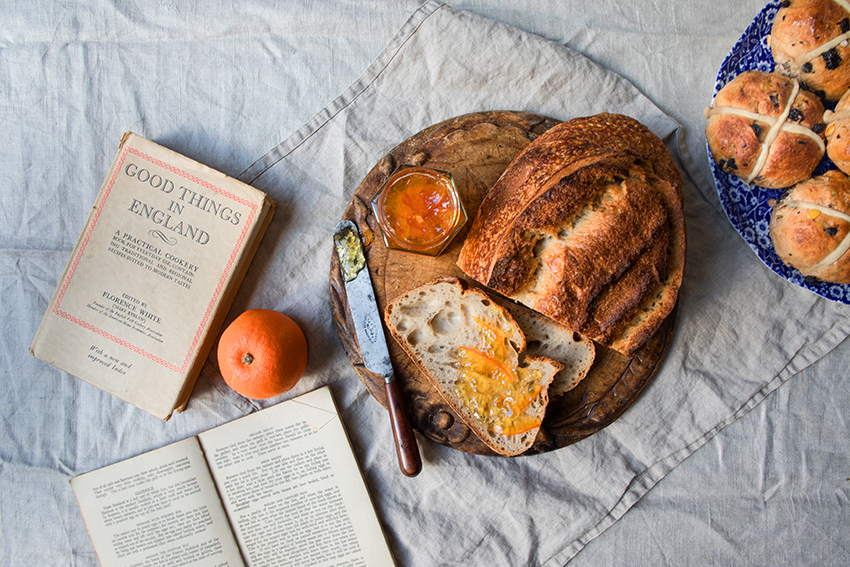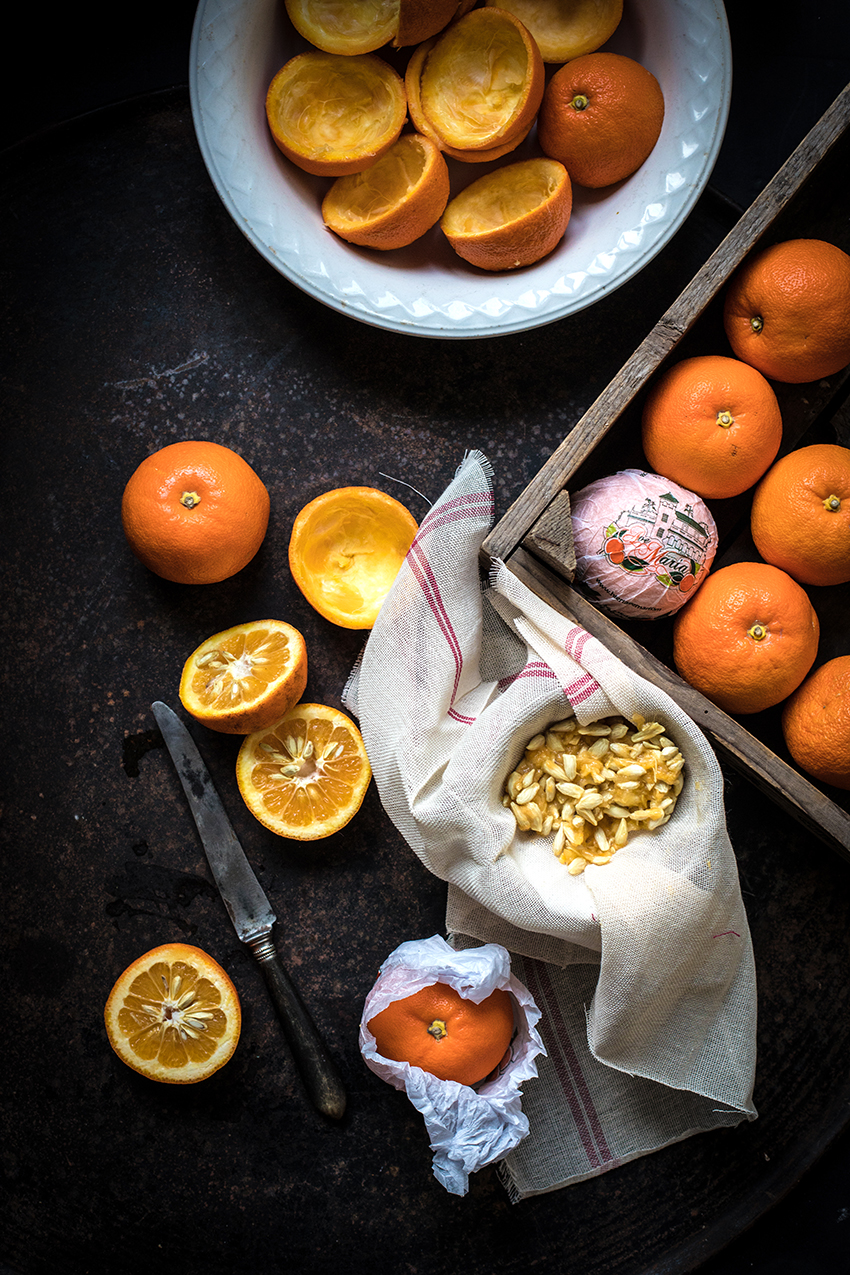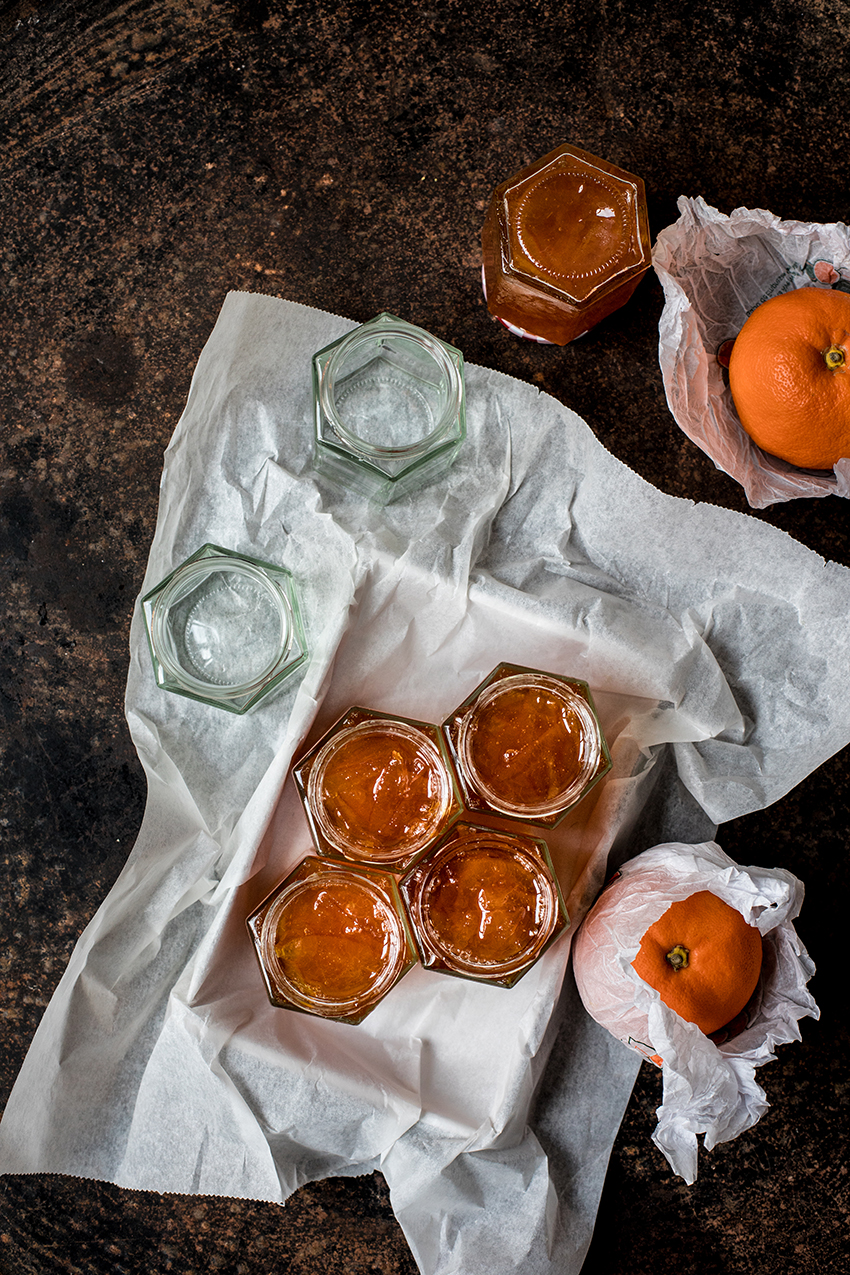Marmalade is like Marmite, you either love it or loathe it.
Marmalade is loved in Britain, smeared on golden toast as the last course of the English Breakfast. The humble jar of sunshine even has its own Marmalade Awards each year in Cumbria in the North of England. Anyone can send in their jar to be judged by marmalade royalty, and my friend Lisa from All Hallows Cookery School in Dorset just won with hers.
In a time when bitter flavour is bred out of vegetables and fruits, you would think many people are not that fond of marmalade. Marmalade is traditionally made from bitter Seville oranges. Originally from Asia, the Moors introduced these oranges in Spain around the 10th century. They are quite inedible in their raw state and if you can manage I salute you. Because of their sourness Seville oranges contain a high amount of pectin. In 17 and 18th century cookery books they get a mention as ‘bitter oranges’ and it wouldn’t be an British classic without a story.
The legend
In the mid 18th century a Spanish ship carrying Seville oranges was damaged by storm. The ship sought refuge in the harbour of Dundee in Scotland where the load deemed unfit for sale were sold to a local merchant called James Keiller. James’ mother turned the bitter orange fruit into jam and so created the iconic James Keiller Dundee Marmalade. It wasn’t a coincidence that James mother made marmalade, in the 1760s her son ran a confectionery shop producing jams in Seagate, Dundee. In 1797 he founded the world’s first marmalade factory producing the first commercial brand of marmalade. In 1828, the company became James Keiller and Son, when his son joined the business. Today you can see stone James Keiller and Son marmalade jars pop up at every carboot sale and antiques market. But the marmalade is still in production, only now in glass jars that off the beautiful radiant orange colour that is so typical of marmalade.
The truth as clear as marmalade
According to Ivan Day, a prominent food historian who I was lucky to do a course with, one of the earliest known recipe for a Marmelet of Oranges dates from around 1677 and it can be found in the recipe book of Eliza Cholmondeley held in the Cheshire Archives and Local Studies.
The earliest recipe in Scotland is titled ‘How to make orange marmalat’ and dates back 1683. It can be found in the earliest Scottish manuscript recipe book which is believed to have been written by Helen, Countess of Sutherland of the Clan Sutherland. The book is dedicated entirely to fruit preservation and jelly making. According to The Scotsman “The Countess was married to John Gordon, the 16th Earl of Sutherland, an army officer who was honoured following the defeat of the 1715 Jacobite rebellion.”
This bit of information transports me right to the wuthering heights of Scotland.
This early Scottish as well as English recipe debunks the myth that mother Keiller invented marmalade. Recipes for similar preserves even date back earlier in history. But the Keiller family definitely deserve a prominent spot in marmalade history.
But why do we call it marmalade and not jam?
As you maybe remember from my posting about ‘Quince Cheese’ here > , quinces are responsible for the word marmalade as their Portuguese word is ‘marmelo’ and they were made into fruit cheeses named marmalades. In Spain they call it ‘Membrillo’. Quince just like bitter Seville oranges, contain a lot of pectin and they are both too sour to eat raw. From both of these fruits the pips and peels are used to get a good set, and if you don’t have quince you could easily make a fruit cheese out of these oranges.
If you’re a marmalade fan, chances are you have a particular favourite. You either love every jar that you can find on your breakfast table or you prefer either thick cut, thin cut, or vintage. The cut of course refers to how thick the peel is cut, I like mine as thin as possible. Vintage is a jar you left in the back of your preserve cupboard to age and turn dark amber in colour and deep in flavour. Then there are two kinds I don’t really want to include in the different types of marmalades and that is the flavoured kind, this could be spices, whisky or any other type of booze. I can understand whisky and grand marnier, but as I’ve made marmalade with cardamom, I have to conclude that that jar was something entirely different to marmalade. When it comes to preserves I’m quite the purist. If additions flavour and not just compliments the taste of the fruit, it’s a big no no for me.
What makes a marmalade
There is something to be said about sugar as well. Some use plain white sugar, others use demerara (cane sugar), others use molasse or jam sugar (minut sugar). You don’t need the added pectin of jam sugar, I find molasse to be too dominant, white sugar from sugar beets is something I hardly use except for jam so I decided to use 2/3 of plain white sugar and 1/3 demerara. I don’t want my marmalade to be dark in colour, I want it to be beautifully bright orange.
And finally the fruit… without wanting to be a food snob, organic or untreated bitter oranges are your only option. Remember that you will be using the peel so your fruit needs to be of the best quality. Many Seville oranges are harvested from trees which grow by the road and in the city. These are dirty oranges. I like to know what I put in my jam jar so it’s better to be safe and buy organic. This isn’t sponsored in any way but I’ve found Ave Maria is a farm that sells organic Sevilles, they are stocked in some British supermarkets (ask them on twitter).
I’ve looked at a couple of recipes and the ingredients and method is usually identical. Before I share my recipe (which is identical to many out there) I’ll leave you with some links for you to look at.
Felicity Cloake for The Guardian: How to make the perfect marmalade >
Giulia Scarpaleggia, my dear Italian friend who has access to the best oranges and makes this marmalade every season in big batches: Bitter Orange marmalade and nothing else >
Orange Marmalade
What do you need
- 1 kg bitter organic oranges (no compromise!)
- 1 large lemon
- 2,5 l water
- 500 g demerara sugar
- 1500 g castor sugar
Equipment
- Stainless steel pot
- Muslin
- a selection of sterilised jars
- a juicer if you have one
- a jam thermometer
Method
(I like to do the prep the evening before, then let it sit overnight, you can however do it in one day)
Juice all your oranges and the lemon, keep the pips and all the bits aside. Place the square of muslin cloth in a bowl and crape the pips and bits into it, close with a twine long enough so you’re able to tie it to the outside of the pot.
Finely slice the peels of the oranges, the thickness is your choice, I like the thinnest I can manage and use my sharpest knife for this. Transfer the shredded peel to the pot, tie the parcel of muslin to the pot and pour over the juice and the water then bring to a boil and leave to simmer for 2-2,5 hours. This is to soften the peel, if you like a bite to the peel, check regularly from 2 hours towards the end of the cooking time.
Leave to cool then remove the muslin parcel and squeeze it as hard as you can to get out as much of the juice as you can.
Now to make the marmalade bring the juice back to a simmer and add the sugar, stir well until it is completely dissolved. Bring to a boil, place a saucer or two in the fridge or freezer and check the temperature to reach 104 degrees – which is when the jam should be setting. Test a bit of jam on one of the cold saucers to see if it sets, if not, continue to boil and try again, and again if needed.
When the marmalade is setting, leave to cool for a few minutes before filling your jars.
After filling I still invert the jars because that is what my grandmother and mother did, but you can add wax or boil again in the jars, whatever method you’re used to.
Use on your hot toast or in cakes or puddings!
Next week… Hot Cross Buns revised!












I like the peel thinly sliced, just like you: lots of work, but when they float in the bright orange marmalade they are a pleasure. I didn’t know the vintage marmalade, I’m going to keep a jar in the back of the pantry and taste the difference in a few years! 🙂
Lovely post, and recipe, and beautiful photos, and very informative introduction, as always!
I found a very vintage one from 8 years ago in the cellar hidden behind some other jars… It’s super dark but I haven’t tasted it… yet
I love your stories, as much as the recipes, and enjoy the beautiful photos. I made last winter several batches of Marmalade,which came out tasty, pure orange colour, and everything else you promised. I wished I could send you a jar, but me living in Jerusalem, made it complicated. As I was reading the stories you wrote, I checked the botanical name of the Seville orange, and realized I had one in my garden. I never managed to get any good jam out of it, (and I make all kinds of them). In israel this orange tree had been used for many years as the base, onto which was grafted some branches of tastier, more delicate kinds of citrus trees. Mine was an old base, that”returned to its wild past”, probably because of overrunning, and looking at your pictures, I thought that this Seville orange wS really living happily in my garden..
Thanks again, and I think I’ll try your lady fingers
Lovely post, but here in the UK seville oranges were over weeks ago! We make a whole year’s supply each January, so there is a natural ageing anyway, but my mum’s secret tip for a dark and caramelly edge is: a spoonful of treacle. Add it with the sugar. We also use the Delia recipe (times three for a year’s supply) but only add one lemon for the whole batch – one lemon per kilo of oranges gives a (to me) too bright and citrusy flavour, which is not what I want with marmalade.
You sound like real marmalade lovers! I know I’m a little late, hopefully it will benefit the people who have a batch frozen! And there’s always next year 😉
My mouth is watering…. always been a fan of marmalade, the history though is a good story. I find marmalade ( thick cut and as bitter as you can get) goes well with cheese. Strong vintage cheddar. ????
Big question – I can’t get hold of bitter Seville oranges in the UAE. Can I make marmalade?!
I’ve tried to make marmalade with just about any other orange and it just never tastes as bitter as you’re used to with marmalade. So you can make jam from regular oranges, it will just be sweet rather than bitter sour!
YUZU is a sour, unique flavored citrus fruit that looks like an orange but is not an orange. It makes an outstanding marmalade. Some folks think yuzu is better than orange for marmalade. I do not know about that, they are different citrus flavors.
KUMQUATS also make excellent marmalade. They are so small, just quarter them, remove the seeds and let them soak in water. This is my favorite for marmalade. Kumquats and duck is a marriage made in heaven. Simmer kumquat marmalade, add a splash of vinegar, a hot chili pepper and some grated ginger together. Use it to top grilled and sliced duck breasts.
CALAMANSI (aka calamondin) might also work for a marmalade. Like kumquat, it is a small fruit that has the sweet and sour citrus thing going on. But I have never gotten enough of them to give marmalade a go. I have only had calamansi juice. I would love to try it as a marmalade.
There are probably other sour citrus beside the Seville orange that would make great marmalade.
Dear Regula,
In the middle of my marmalade production, when I searched, for using Demerara and discovered your site. Impressed with your graphics and especially the fact your a beer sommelier, a subject close to my heart.
I like my marmalade chunky with ginger which is this present batch, however I’ll add Demerara cut to 25% as I’m not so keen on the intensity of flavour. I’m actually using some blood oranges from Uruguay.
Thank you for your suggestions.
Yours Simon
New Glasgow, Nova Scotia, Canada
P.S I have some very hard crab apples growing in my garden any suggestions?
dear Regula
I can never get my marmalade right. I don’t want to use commercial pectin, but I always have to boil for too long to get any sort of setting point and the result is a thick and intensively flavoured result. It does have its fans in my family but I am getting discouraged.
I note from your pictures that you leave the pith on the peel and I never do this. Is this where I am going wrong.
Any help would be much appreciated
Hi John,
Yes, it is the pith in citrus that is pectin-rich. Definitely leave the pith on when making marmalade. The white stuff pretty much disappears when boiling, but it is what thickens the marmalade. You can make citrus pectin by soaking then boiling just the citrus pith, not the peel, just the pith, then straining it. That resulting pectin can be used in other recipes.